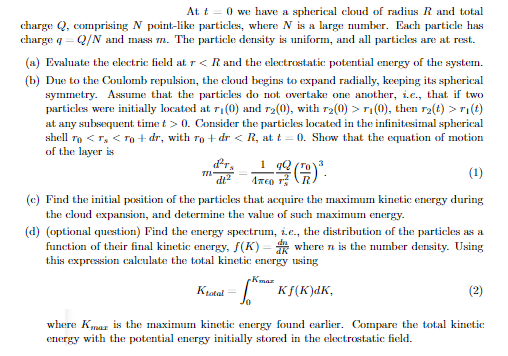At t = 0 we have a spherical cloud of radius R and total charge Q, comprising N point-like particles, where N is a large mumber. Each particle haN charge q = Q/N and mass m. The particle density is uniform, and all particles are at rest. (a) Evaluate the clectric field at r< R and the eloctrostatic potential energy of the system. (b) Due to the Coulomb repulsion, the cloud bogins to expand radially, koeping its spherical symmetry. Assume that the particles do not overtake one another, i.c., that if two particles were initially located at ri (0) and r2(0), with r2(0) > r1(0), then r2(t) > ri(t) at any subsoquent. time t > 0. Consider the particles located in the infinitesimal spherical shell ro < r, < ro + dr, with ro + dr < R, at t = 0. Show that the equation of motion of the layer is dr, (1)
At t = 0 we have a spherical cloud of radius R and total charge Q, comprising N point-like particles, where N is a large mumber. Each particle haN charge q = Q/N and mass m. The particle density is uniform, and all particles are at rest. (a) Evaluate the clectric field at r< R and the eloctrostatic potential energy of the system. (b) Due to the Coulomb repulsion, the cloud bogins to expand radially, koeping its spherical symmetry. Assume that the particles do not overtake one another, i.c., that if two particles were initially located at ri (0) and r2(0), with r2(0) > r1(0), then r2(t) > ri(t) at any subsoquent. time t > 0. Consider the particles located in the infinitesimal spherical shell ro < r, < ro + dr, with ro + dr < R, at t = 0. Show that the equation of motion of the layer is dr, (1)
Related questions
Question

Transcribed Image Text:At t = 0 we have a spherical cloud of radius R and total
charge Q, comprising N point-like particles, where N is a large mumber. Each particle has
charge q = Q/N and mass m. The particle density is uniform, and all particles are at rest.
(a) Evaluate the electric field at r< R and the electrostatic potential energy of the system.
(b) Due to the Coulomb repulsion, the cloud begins to expand radially, keeping its spherical
symmetry. Assume that the particles do not overtake one another, i.e., that if two
particles were initially located at ri(0) and r2(0), with r2(0) > ri(0), then r2(t) > ri(t)
at any subsequent time t> 0. Consider the particles located in the infinitesimal spherical
shell ro <r, < To + dr, with ro + dr < R, at t = 0. Show that the equation of motion
of the layer is
1
(1)
dt?
(c) Find the initial position of the particles that acquire the maximum kinetic energy during
the cloud expansion, and determine the value of such maximum energy.
the particles as a
(d) (optional question) Find the energy spectrum, ie., the distribution
function of their final kinetic energy, f(K) = * where n is the mumber density. Using
this expression calculate the total kinetic energy using
Kmar
Kratal
Kf(K)dK,
(2)
Jo
where Kmaz is the maximum kinetic energy found earlier. Compare the total kinetic
energy with the potential energy initially stored in the electrostatic field.
Expert Solution
Step 1
Given:
The sphere of the radius is .
The total charge in the sphere is .
The total number of the charged particles are .
The charge on each particle is .
Trending now
This is a popular solution!
Step by step
Solved in 3 steps
